There are a wide variety of different types of shoes. Most types of shoes are designed for specific activities. For example, boots are typically designed for work or heavy outdoor use. Athletic shoes are designed for particular sports such as running, walking, or other sports. Some shoes are designed to be worn at more formal occasions, and others are designed for casual wear. There are also a wide variety of shoes designed for different types of dancing. Orthopedic shoes are special types of footwear designed for individuals with particular foot problems or special needs. Other animals, such as dogs and horses, may also wear special shoes to protect their feet as well.
Depending on the activity for which they are designed, some types of footwear may fit into multiple categories. For example, Cowboy boots are considered boots, but may also be worn in more formal occasions and used as dress shoes. Hiking boots incorporate many of the protective features of boots, but also provide the extra flexibility and comfort of many athletic shoes. Flip-flops are considered casual footwear, but have also been worn in formal occasions, such as visits to the White House.[35][36]
Athletic
Athletic shoes are specifically designed to be worn for participating in various sports. Sincefriction between the foot and the ground is an important force in most sports, modern athletic shoes are designed to maximize this force, and materials, such as rubber, are used. Although, for some activities such as dancing or bowling, sliding is desirable, so shoes designed for these activities often have lower coefficients of friction.[37] The earliest athletic shoes date back to the mid 19th century were track spikes — leather shoes with metalcleats on the soles to provide increased friction during running. They were developed by J.W. Foster & Sons, which later become known as Reebok. By the end of the 19th century,Spalding also manufactured these shoes as well. Adidas started selling shoes with track spikes in them for running and soccer in 1925. Spikes were eventually added to shoes forbaseball and American football in the 20th century.[9] Golfers also use shoes with small metal spikes on their soles to prevent slipping during their swing.[38]
The earliest rubber-soled athletic shoes date back to 1876 in the United Kingdom, when the New Liverpool Rubber Company madeplimsolls, or sandshoes, designed for the sport of croquet. Similar rubber-soled shoes were made in 1892 in the United States by Humphrey O'Sullivan, based on Charles Goodyear's technology. The United States Rubber Company was founded the same year and produced rubber-soled and heeled shoes under a variety of brand names, which were later consolidated in 1916 under the name, Keds. These shoes became known as, "sneakers", because the rubber sole allowed the wearer to sneak up on another person. In 1964, the founding of Nike by Phil Knight and Bill Bowerman of the University of Oregon introduced many new improvements common in modern running shoes, such as rubber waffle soles, breathable nylon uppers, and cushioning in the mid-sole and heel. During the 1970s, the expertise of podiatrists also became important in athletic shoe design, to implement new design features based on how feet reacted to specific actions, such as running, jumping, or side-to-side movement. Athletic shoes for women were also designed for their specific physiological differences.[9]
Shoes specific to the sport of basketball were developed by Chuck Taylor, and are popularly known as Chuck Taylor All-Stars. These shoes, first sold in 1917, are double-layer canvasshoes with rubber soles and toe caps, and a high heel (known as a "high top") for added support. In 1969, Taylor was inducted into the Naismith Memorial Basketball Hall of Fame in recognition of this development, and in the 1970s, other shoe manufacturers, such as Nike, Adidas, Reebok, and others began imitating this style of athletic shoe.[39] In April 1985, Nike introduced its own brand of basketball shoe which would become popular in its own right, theAir Jordan, named after the then-rookie Chicago Bulls basketball player, Michael Jordan. The Air Jordan line of shoes sold $100 million in their first year.[40]
As barefoot running became popular by the late 20th and early 21st century, many modern shoe manufacturers have recently designed footwear that mimic this experience, maintaining optimum flexibility and natural walking while also providing some degree of protection. The purpose of these "minimalist shoes" is to allow one's feet and legs to feel more subtly the impacts and forces involved in running, allowing finer adjustments in running style.[41] Some of these shoes include the Vibram FiveFingers,[42] Nike Free,[43] and Saucony's Kinvara and Hattori.[44][45] Mexican huaraches are also very simple running shoes, similar to the shoes worn by the Tarahumara people of northern Mexico, who are known for their distance running abilities.[46] Wrestling shoes are also very light and flexible shoes that are designed to mimic bare feet while providing additional traction and protection.
Many athletic shoes are designed with specific features for specific activities. One of these includes roller skates, which have metal or plastic wheels on the bottom specific for the sport of roller skating. Similarly, ice skates have a metal blade attached to the bottom for locomotion across ice. Skate shoes have also been designed to provide a comfortable, flexible and durable shoe for the sport ofskateboarding.[47] Climbing shoes are rubber-soled, tight-fitting shoes designed to fit in the small cracks and crevices for rock climbing.Cycling shoes are similarly designed with rubber soles and a tight fit, but also are equipped with a metal or plastic cleat to interface with clipless pedals, as well as a stiff sole to maximize power transfer and support the foot.[48]
Boot
Main article: Boot
A boot is a special type of shoe which covers the foot and the ankle and extends up the leg, sometimes as far as the knee or even the hip. Most boots have a heel that is clearly distinguishable from the rest of the sole, even if the two are made of one piece. They are typically made of leather or rubber, although they may be made from a variety of different materials. Boots are worn both for their functionality — protecting the foot and leg from water, snow, mud or hazards or providing additional ankle support for strenuous activities — as well as for reasons of style and fashion.
Cowboy boots are a specific style of riding boot which combines function with fashion. They became popular among cowboys in the western United States during the 19th century. Traditional cowboy boots have a Cuban heel, rounded to pointed toe, high shaft, and, traditionally, no lacing.[49] They are normally made from cowhide leather but may be made from more exotic skins such as ostrich, anaconda, or elephant skins.[50]
Hiking boots are designed to provide extra ankle and arch support, as well as extra padding for comfort during hiking. They are constructed to provide comfort for miles of walking over rough terrains, and protect the hiker's feet against water, mud, rocks, and other wilderness obstacles. These boots support the ankle to avoid twisting but do not restrict the ankle's movement too much. They are fairly stiff to support the foot. A properly fitted boot and/or friction-reducing patches applied to troublesome areas ensures protection againstblisters and other discomforts associated with long hikes on rugged terrain.[51]
During wet or snowy weather, snow boots are worn to keep the foot warm and dry. They are typically made of rubber or other water-resistant material, have multiple layers of insulation, and a high heel to keep snow out.[52] Boots may also be attached to snowshoes to increase the distribution of weight over a larger surface area for walking in snow. Ski boots are a specialized snow boot which are used in alpine or cross-country skiing and designed to provide a way to attach the skier to his/her skis using ski bindings. The ski/boot/binding combination is used to effectively transmit control inputs from the skier's legs to the snow. Ice skates are another specialized boot with a metal blade attached to the bottom which is used to propel the wearer across a sheet of ice.[53] Inline skatesare similar to ice skates but with a set of three to four wheels in lieu of the blade, which are designed to mimic ice skating on solid surfaces such as wood or concrete.[54]
Boots are designed to withstand heavy wear to protect the wearer and provide good traction. They are generally made from sturdy leather uppers and non-leather outsoles. They may be used for uniforms of the police or military, as well as for protection in industrial settings such as mining and construction. Protective features may include steel-tipped toes and soles or ankle guards.[55]
Dress and casual
Dress shoes are characterized by smooth and supple leather uppers, leather soles, and narrow sleek figure. Casual shoes are characterized by sturdy leather uppers, non-leather outsoles, and wide profile.
Some designs of dress shoes can be worn by either gender. The majority of dress shoes have an upper covering, commonly made of leather, enclosing most of the lower foot, but not covering the ankles. This upper part of the shoe is often made without apertures or openings, but may also be made with openings or even itself consist of a series of straps, e.g. an open toe featured in women's shoes. Shoes with uppers made high to cover the ankles are also available; a shoe with the upper rising above the ankle is usually considered a boot but certain styles may be referred to as high-topped shoes or high-tops. Usually, a high-topped shoe is secured by laces or zippers, although some styles have elastic inserts to ease slipping the shoe on.
Men's
Men's shoes can be categorized by how they are closed:
- Oxfords (also referred as "Balmorals"): the vamp has a V-shaped slit to which the laces are attached; also known as "closed lacing". The word "Oxford" is sometimes used by American clothing companies to market shoes that are not Balmorals, such as Blüchers.
- Derby shoe: the laces are tied to two pieces of leather independently attached to the vamp; also known as "open lacing" and is a step down in dressiness. If the laces are not independently attached to the vamp, the shoe is known as a blucher shoe. This name is, in American English, often used about derbys.
- Monk-straps: a buckle and strap instead of lacing
- Slip-ons: There are no lacings or fastenings. The popular loafers are part of this category, as well as less popular styles, such as elastic-sided shoes.
Men's shoes can also be decorated in various ways:
- Plain-toes: have a sleek appearance and no extra decorations on the vamp.
- Cap-toes: has an extra layer of leather that "caps" the toe.
- Brogues (American: wing-tips): The toe of the shoe is covered with a perforated panel, the wing-tip, which extends down either side of the shoe. Brogues can be found in both balmoral and blucher styles, but are considered slightly less formal.
Formal high-end men's shoes are manufactured by several companies around the world, most notably in England, France, Italy, and America. Notable British brands include: Church's English Shoes (est. 1873), John Lobb Bootmaker (est. 1849), Edward Green Shoes(est. 1890), and Crockett & Jones (est. 1879). Both John Lobb and Edward Green offer bespoke products. In between the world wars, men's footwear received significant innovation and design, led by cobblers and cordwainers in London's West End.[56] The most notable[according to whom?] French product is made by J.M. Weston. Armani of Italy was a major influence on men's shoe design in the 1960s–1980s until they returned to the larger proportions of its forebears, the welt-constructed Anglo-American dress shoe originally created in Edwardian England. Another well-known Italian company is Salvatore Ferragamo Italia S.p.A.. The remaining elite[clarification needed] American companies are Allen Edmonds and Alden Shoe Company. Alden, located in New England, specializes in genuine shell cordovan leather from the only remaining horse tannery in America (Chicago)[57] and is completely manufactured in America, whereas Allen Edmonds, of Wisconsin, is a larger company that outsources some of its production.[58]
Women's
There is a large variety of shoes available for women, in addition to most of the men's styles being more accepted as unisex. Some broad categories are:
- High-heeled footwear is footwear that raises the heels, typically 2 inches (5 cm) or more above the toes, commonly worn by women for formal occasions or social outings. Variants include kitten heels (typically 1½-2 inches high) and stilletto heels (with a very narrow heel post) and wedge heels (with a wedge-shaped sole rather than a heel post).
- Mules are shoes or slippers with no fitting around the heel (i.e. they are backless)
- Slingbacks are shoes which are secured by a strap behind the heel, rather than over the top of the foot.
- Ballet flats, known in the UK as ballerinas, ballet pumps or skimmers, are shoes with a very low heel and a relatively short vamp, exposing much of the instep. They are popular for warm-weather wear, and may be seen as more comfortable than shoes with a higher heel.
- Court shoes, known in the United States as pumps, are typically high-heeled, slip-on dress shoes.
Unisex
- Clog
- Platform shoe: shoe with very thick soles and heels
- Sandals: open shoes consisting of a sole and various straps, leaving much of the foot exposed to air. They are thus popular for warm-weather wear, because they let the foot be cooler than a closed-toed shoe would.
- Saddle shoe: leather shoe with a contrasting saddle-shaped band over the instep, typically white uppers with black "saddle".
- Slip-on shoe: a dress or casual shoe without laces; often with tassels, buckles, or coin-holders (penny loafers).
- Boat shoes, also known as "deck shoes": similar to a loafer, but more casual. Laces are usually simple leather with no frills. Typically made of leather and featuring a soft white sole to avoid marring or scratching a boat deck. The first boat shoe was invented in 1935 by Paul Sperry.
- Slippers: For indoor use, commonly worn with pajamas.
Dance
A wide variety of footwear is used by dancers. The choice of dance shoe type depends on the style of dance that is to be performed and, in many cases, the characteristics of the surface that will be danced on.
- Pointe shoes are designed for ballet dancing. These have a toe box that is stiffened with glue and a hardened sole so the dancer can stand on the tips of their toes. They are secured by elastic straps and ribbons that are tied to the dancer's ankles.
- Ballet shoes are soft, pliable shoes made of canvas or leather, with either continuous or two-part sole (also called split-sole), used for ballet dancing. The sole is typically made of leather, with thicker material under the ball and heel of the foot, and thinner and thus more flexible material under the arch so that the foot can be easily pointed. They are typically secured by elastics across the top of the foot.
- Ghillies are soft shoes that are used in Irish dance, Scottish country dance, and highland dance.
- Jazz shoes typically have a two-part rubberized sole (also called split-sole) to provide both flexibility and traction, and a short heel. They are secured to the foot by laces or elastic inserts.
- Tango and Flamenco shoes are used for tango or flamenco dancing.
- Ballroom shoes fall into two categories: Ballroom and Latin American. Both are characterised by suede soles. Men's ballroom shoes are typically lace-ups with one-inch heels and patent leather uppers. Ladies' ballroom shoes are typically court shoes with two-inch heels, made of fabric that can be colored to match the dancer's dress. In contrast to the low Ballroom heel, which evenly distributes weight across the foot, Latin American shoes have higher heels designed to shift weight onto the toes. Latin shoes are also more flexible than ballroom shoes. Men's Latin shoes typically have 1.5- to 2-inch high, shaped heels, while Ladies' Latin shoes have 2,5-inch to 3-inch heels. Ladies shoes are typically open-toed and strapped.
- Dance sneakers are lightweight sneakers with reinforced rubber toes that allows dancers to briefly stand on their toes. These are known by various trademarked names, such as dansneakers.
- Foot thongs are slip-on, partial foot covers that cover the ball of the dancer's foot so as to reduce friction while executing turns, thus making it easier to perform turns and also protecting the foot from skin abrasions. From a distance, flesh colored foot thongs give a dancer the appearance of having bare feet. They are known by various names depending on the manufacturer, including dance paws, foot undies, and foot paws.
- Tap shoes have metal plates mounted to the bottoms of the toe and heel. The metal plates, which are known as taps, make a loud sound when struck against a hard performance surface. Tap shoes, which are used in tap dancing, may be made from any style of shoe to which taps can be attached.
- Character shoes are leather shoes with one- to three-inch heels, usually with one or more straps across the instep to secure it to the foot. They may be soft-soled (suede) or hard-soled. They may be converted to tap shoes by attaching taps.
Orthopedic
Orthopedic shoes are specially-designed footwear to relieve discomfort associated with many foot and ankle disorders, such as blisters,bunions, calluses and corns, hammer toes, plantar fasciitis, or heel spurs. They may also be worn by individuals with diabetes or people with unequal leg length. These shoes typically have a low heel, tend to be wide with a particularly wide toe box, and have a firm heel to provide extra support. Some may also have a removable insole, or orthotic, to provide extra arch support.[9]
Non-human
While most shoes have historically been worn by humans, there are simple shoes that are designed to be worn by other domesticated animals, such as dogs and horses. A horseshoeis a man-made product, normally made of metal or other modern synthetic materials, designed to protect a horse's hoof from wear and tear. Horseshoes are attached on the palmar surface of the hooves, usually nailed through the insensitive hoof wall that is anatomically akin to the human toenail, though much larger and thicker. They may also beglued.
It is unknown who invented the original horseshoe. Horsemen in Asia constructed horse booties from leather and plant material. During the first century, the Romans made leather and metal shoes called hipposandals. By approximately the 6th or 7th centuries, horsemen in Europe nailed metal shoes to horses' hooves. By 1000 AD, cast bronze horseshoes with nail holes had became common in Europe. Iron horseshoes became common by the 13th or 14th century.[53]
Horseshoes are available in a wide variety of materials and styles, developed for different types of horse and for the work they do. The most common materials are steel and aluminum, but specialized shoes may include use of rubber, plastic, magnesium, titanium, or copper.[59] Steel tends to be preferred in sports where a strong, long-wearing shoe is needed, such as polo, eventing, show jumping, and western riding events. Aluminum shoes are lighter, making them common in horse racing, where a lighter shoe is desired; and often facilitate certain types of desired movement, and so are favored in the discipline ofdressage.[60] Some horseshoes have "caulkins", "caulks", or "calks": protrusions at the toe and/or heels of the shoe, to provide additional traction.
Dogs are another domesticated animal for which shoes have been constructed. Some native American tribes, such as the Cree orSalteaux, used dog shoes to protect their feet during activities such as dog sledding, since the ice could wear the pads on a dog's foot thin, sometimes resulting in bleeding.[61] Modern dog boots may also be used for other outdoor activities, such as hunting and hiking, to prevent slippage in wet or snowy weather as well as to keep snow from accumulating between the dog's toes. There are many different shapes and sizes available, and they may be made of a variety of materials, but commonly they are made of leather, neoprene,Cordura, or may even be home-made out of cotton and duct tape.[62]
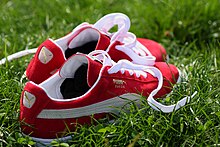

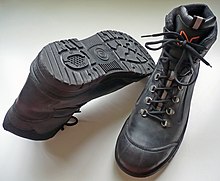

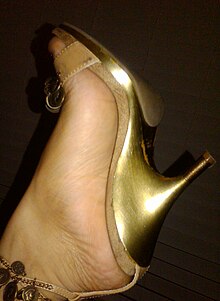
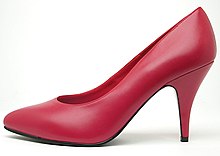








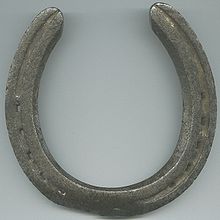
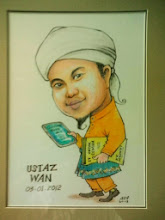
No comments:
Post a Comment